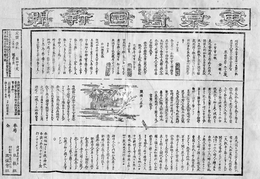Mainichi Shimbun
| Tillkomst | 1872 | |
|---|---|---|
| Land | Japan | |
| Säte | Tokyo prefektur | |
| Ersätter | Tokyo Nichi Nichi Shimbun, Ōsaka Mainichi Shimbun | |
| Utgivare | The Mainichi Newspapers Co. | |
| Ursprungsland | Japan | |
| Verkets eller namnets språk | japanska | |
| Tidningsformat | fullformat | |
| Webbplats | mainichi.jp | |
| Utgivningsintervall | 0,5 dygn | |
Mainichi Shimbun(japanska: 毎日新聞,?, Mainichi Shinbun), grundad 1872 som Tokyo Nichi-nichi Shimbun är en av Japans största dagstidningar. Huvudkontoret ligger i Tokyo. Tidningen sponsrar ett hedrande filmpris sedan 1946. Sedan 1952 delas även ett prestigefyllt pris för konstnärlig formgivning ut varje år i tidningens namn och med tidningen som huvudsponsor. Priset är huvudsakligen ämnat japansk design, men 1961 tilldelades det den österrikiske bildkonstnären Friedensreich Hundertwasser.
Externa länkar
Media som används på denna webbplats
Icon of simple gray pencil. An icon for Russian Wikipedia RFAR page.
First issue frontpage of Mainichi Shimbun Frontpage, 21 February 1872 (Lunar calendar). It's March 29 according to the Gregorian calendar. It was then called the Tokyo Nichinichi Shimbun.
While many of the newspapers launched in the early Meiji era disappeared or were absorbed, theTokyo Nichi Nichi Shimbun continued to exist until the Showa era, leading to the current Mainichi Shimbun.
This first issue of the Tokyo Nichi Nichi Shimbun is printed on Japanese paper called Mino Paper, not Western paper, and the content is the "Government Bulletin" that publishes government decree and official documents and the general news "Eko Sodan It was about two. To the right of the title is a red stamp of "government permit" that the government has given permission.
In addition, an organization name of the government, "daijō-kan", "the state cults", such as the price of the newspaper is in the statements and momme rather than a circle,
in a really feel like the early Meiji era of the newspaper to leave the state of the still Edo period, modern times It is a material that can be said to be a document in the process of changing from a document to a modern document.

